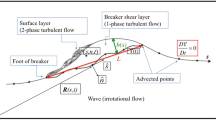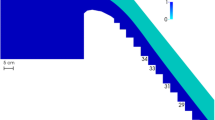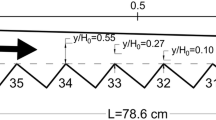Abstract
In the present work, the velocity field and the vorticity generation in the spilling generated by a NACA 0024 hydrofoil were studied. SPH simulations were obtained by a pseudo-compressible XSPH scheme with pressure smoothing; both an algebraic mixing-length model and a two-equation model were used to represent turbulent stresses. Given the key role of vortical motions in the generation of the spilling breaker, the sources of vorticity were then examined in detail to confirm the interpretation of the mean flow vortical dynamics given in a paper by Dabiri and Gharib (J Fluid Mech 330: 113–139, [1997]). The high precision of the SPH model is confirmed through a comparison with experimental data. Experimental investigations were carried out by measuring the velocity field with a backscatter, two-component four-beam optic-fiber LDA system. The agreement between the numerical results and laboratory measurements in the wake region is satisfactory and allows the evaluation of the wave breaking efficiency of the device by a detailed analysis of the simulated flow field.













Similar content being viewed by others
References
Antoci C, Gallati M, Sibilla S (2008) Numerical simulation of fluid-structure interaction. Comp Struct 85:879–890
Antuono M, Colagrossi A, Marrone S, Molteni D (2010) Free-surface flows solved by means of SPH schemes with numerical diffusive terms. Comp Phys Comm 181(3):532–549
Banner ML, Peregrine DH (1993) Wave breaking in deep water. Ann Re Fluid Mech 25:373–397
Banner ML, Phillips OM (1974) On the incipient breaking of small scale waves. J Fluid Mech 65:647–656
Battjes JA, Sakai T (1981) Velocity field in a steady breaker. J Fluid Mech 111:21–437
Chen JK, Beraun JE (2000) A generalized smoothed particle hydrodynamics method for nonlinear dynamic problems. Comput Meth Appl Mech Eng 190(1–2):225–239
Cointe R, Tulin M (1994) A theory of steady breakers. J Fluid Mech 276:1–20
Colagrossi A, Landrini M (2003) Numerical simulation of interfacial flows by smoothed particle hydrodynamics. J Comp Phys 191:448–475
Dabiri D, Gharib M (1997) Experimental investigation of the vorticity generation within a spilling water wave. J Fluid Mech 330:113–139
De Padova D, Dalrymple RA, Mossa M, Petrillo AF (2008) An analysis of SPH smoothing function modelling a regular breaking wave. Proc. Nat. Conf. XXXI Convegno Nazionale di Idraulica e Costruzioni Idrauliche, Perugia, pp 182–182
De Padova D, Mossa M, Sibilla S (2009) Laboratory experiments and SPH modelling of hydraulic jumps. Proc. Int. Conf. 4th Spheric Workshop, Nantes, pp 255–257
De Padova D, Mossa M, Sibilla S, Torti E (2010) Hydraulic jump simulation by SPH. Proc. Int. Conf. 5th Spheric Workshop, Manchester, pp 50–55
De Padova D, Mossa M, Sibilla S, Torti E (2013) 3D SPH modelling of hydraulic jump in a very large channel. J Hydraulic Res 51:158–173
Dehnen W, Aly H (2012) Improving convergence in smoothed particle hydrodynamics simulations without pairing instability. Monthly Not Royal Astr Soc 425:1068–1082
Di Monaco A, Manenti S, Gallati M, Sibilla S, Agate G, Guandalini R (2011) SPH modeling of solid boundaries through a semi-analytic approach. Eng Appl Comp Fluid Mech 5:1–15
Duncan JH (1981) An experimental investigation of breaking waves produced by a towed hydrofoil. Proc R Soc Lond A 377:331–348
Duncan JH (1983) The breaking and non-breaking wave resistance of two-dimensional hydrofoil. J Fluid Mech 126:507–520
Duncan JH, Philomin V (1994) The formation of spilling breaking water waves. Phys Fluids 8:2558–2560
Espa P, Sibilla S, Gallati M (2008) SPH simulations of a vertical 2-D liquid jet introduced from the bottom of a free-surface rectangular tank. Adv Appl Fluid Mech 3:105–140
Gallati M, Braschi G (2003) Numerical description of the jump formation over a sill via SPH method. In: Proceedings of International Conference Modelling Fluid Flow CMFF-03, Budapest, pp 845–852
Gingold RA, Monaghan JJ (1977) Smoothed particle hydrodynamics: theory and application to nonspherical stars. Mon Not R Astron Soc 181:375–389
Gomez-Gesteira M, Rogers BD, Darlymple RA, Crespo AJC (2010) State-of-the-art of classical SPH for free-surface flows. J Hydraulic Res 48:6–27
Gotoh H, Ikari H, Memita T, Sakai T (2005) Lagrangian particle method for simulation of wave overtopping on a vertical seawall. Coast Eng J 47(2–3):157–181
Grenier N, Le Touzé D, Colagrossi A, Antuono M, Colicchio G (2013) Viscous bubbly flow simulation with an interface SPH model. Ocean Eng 69:88–102
Launder BE, Spalding DB (1974) The numerical computation of turbulent flows. Comp Meth Appl Mech Eng 3:269–289
Lin JC, Rockwell D (1994) Instantaneous structure of a breaking wave. Phys Fluids 6:2877–2879
Lin JC, Rockwell D (1995) Evolution of a quasi-steady breaking wave. J Fluid Mech 302:29–44
Liu GR, Liu MB (2007) Smoothed particle hydrodynamics—a meshfree particle methods. World Scientific Publishing, Singapore
Liu GR, Liu MB (2010) Smoothed particle hydrodynamics (SPH): an overview and recent developments. Arch Comput Methods Eng 17:25–76
Lucy L (1977) A numerical approach to the testing of fusion process. J Astron 82:1013–1024
Manenti S, Sibilla S, Gallati M, Agate G, Guandalini R (2012) SPH simulation of sediment flushing induced by a rapid water flow. J Hydraulic Eng 138:272–284
Miyata H, Inui T (1984) Nonlinear ship waves. Adv Appl Mech 24:215–288
Monaghan JJ (1992) Smoothed particle hydrodynamics. Ann Rev Astron Astrophys 30:543–574
Monaghan JJ (1992) Simulating free surface flows with SPH. J Comp Phys 110(2):399–406
Monaghan JJ (2005) Smoothed particle hydrodynamics. Rep Prog Phys 68:1703–1759
Mohaghan JJ, Kocharyan A (1995) SPH simulation of multi-phase flow. Comput Phys Commun 87:225–235
Monaghan JJ, Lattanzio JC (1985) A refined particle method for astrophysical problems. Astron Astrophys 149:135–143
Morris JP (1996) A study of the stability properties of smooth particle hydrodynamics. Publ Astron Soc Austr 13:97–102
Mossa M (2008) Experimental study of the flow field with spilling type breaking. J Hydraulic Res 46:81–86
Peregrine DH, Svendsen IA (1978) Spilling breakers, bores and hydraulic jumps. Coast Eng 30:540–550
Randles PW, Libersky LD (1996) Smoothed particle hydrodynamics: some recent improvements and applications. Comput Methods Appl Mech Eng 139(1–4):375–408
Shadloo MS, Zainali A, Sadek SH, Yildiz M (2011) Improved incompressible smoothed particle hydrodynamics method for simulating flow around bluff bodies. Comput Methods Appl Mech Eng 200:1008–1020
Shao SD, Lo EYM (2003) Incompressible SPH method for simulating Newtonian and non-Newtonian flows with a free surface. Adv Water Res 26(7):787–800
Sheldahl RE, Klimas PC (1980) Aerodynamic characteristics of seven symmetrical airfoil sections through 180° angle of attack for use in aerodynamic analysis of vertical axis wind turbines. Sandia National Laboratories Report 80-2114
Sibilla S (2008) SPH simulation of local scour processes. ERCOFTAC Bull 76:41–44
Tennekes H, Lumley JL (1981) A first course in turbulence. The MIT Press, Cambridge
Tulin MP, Cointe R (1986) A theory of spilling breakers. In: Proceeding 16th Symposium. Naval Hydrodynamics, Berkley, National Academy Press, Washington DC, pp 93–105
Violeau D (2012) Fluid mechanics and the SPH method: theory and applications. Oxford University Press, Oxford
Wendland H (1995) Piecewise polynomial, positive definite and compactly supported radial functions of minimal degree. Adv Comput Math 4:389–396
Willmott CJ (1981) On the validation of models. Phys Geogr 2:184–194
Author information
Authors and Affiliations
Corresponding author
Rights and permissions
About this article
Cite this article
De Padova, D., Mossa, M. & Sibilla, S. SPH numerical investigation of the velocity field and vorticity generation within a hydrofoil-induced spilling breaker. Environ Fluid Mech 16, 267–287 (2016). https://doi.org/10.1007/s10652-015-9433-0
Received:
Accepted:
Published:
Issue Date:
DOI: https://doi.org/10.1007/s10652-015-9433-0




